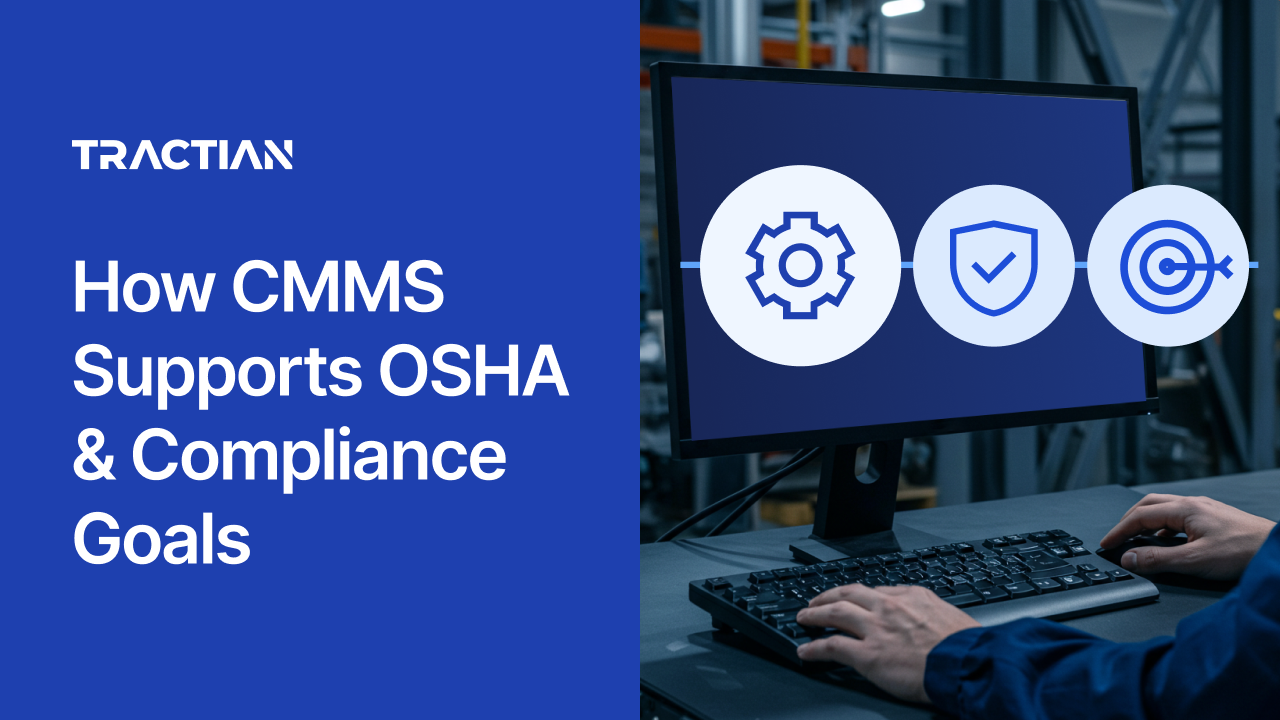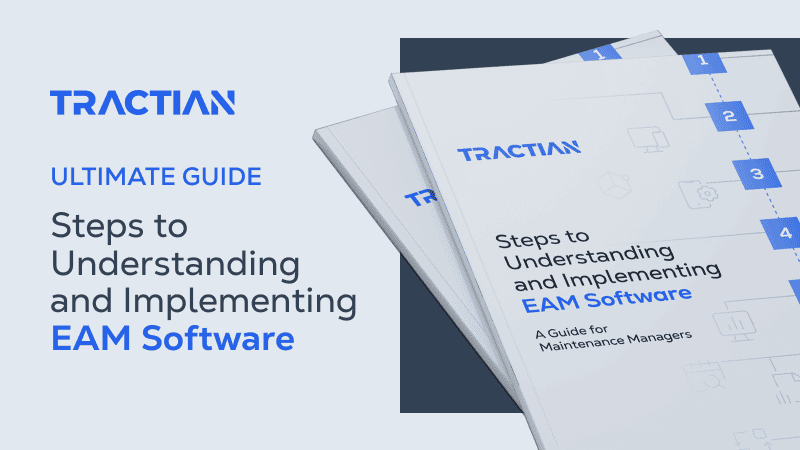OSHA compliance is an all-encompassing system. For those who work with its regulations, it can feel like it’s their entire job. For maintenance teams, satisfying OSHA requirements is one of the most demanding and unavoidable hassles of the job.
And, as tedious as it can be, the consequences teams seek to avoid are equally serious
A missed inspection, a forgotten record, or a delayed repair doesn’t just impact safety risks and standards for the team. They also put the entire production operation at risk, both legally and financially.
Often enough, compliance is treated as a paperwork burden. But those managing the implementation of requirements and practices know the real challenge is operational.
How do you make sure every safety-related task is completed on time, properly documented, and aligned with federal standards, without slowing production or overwhelming your team?
That’s precisely what we’ll discuss in this article: how a CMMS (Computerized Maintenance Management System) helps industrial teams meet OSHA requirements while embedding safety into the maintenance routine.
What is OSHA and What Does It Require?
OSHA, short for the Occupational Safety and Health Administration, sets and enforces workplace safety standards across the U.S. Its core mission is simple: to ensure safe and healthy working conditions for employees.
But for maintenance teams, that mission translates into a long list of detailed requirements that affect daily routines, documentation practices, and equipment upkeep.
In industrial environments, OSHA standards touch almost every aspect of maintenance, from lockout/tagout procedures and machine guarding to electrical safety and hazard communication. There is much to do, and it’s not only about having the proper protocols in place.
Teams must prove those protocols are followed, tracked, and verified in real time.
To do this, teams must keep accurate maintenance records, ensuring scheduled inspections are completed, documenting corrective actions, and showing that safety-critical equipment is maintained according to federal expectations. If a regulator walks on the floor, the proof has to be accessible and ready to examine.
How OSHA Impacts Maintenance Teams
For maintenance teams, OSHA compliance is more than a regulatory requirement since it also defines how daily work is structured, prioritized, and reported. Unlike general safety policies, OSHA standards come with legal weight and detailed rules that directly affect how maintenance procedures are performed on the floor.
Take preventive maintenance, for example. Under OSHA, it’s not enough to inspect machines “periodically.” There must be defined intervals, written procedures, assigned responsibilities, and proof that tasks were completed.
Every lubrication, calibration, or parts replacement that impacts safety must be traceable, down to the technician, timestamp, and outcome.
And then there’s the documentation.
Every safety check, work order, and corrective action tied to a hazard must be logged and stored. If OSHA requests records for a specific asset or event, maintenance leaders need to pull that data fast, and it needs to be complete, consistent, and compliant with recordkeeping rules like 29 CFR 1910.
Beyond documentation, OSHA also affects team structures. It requires that only qualified personnel perform safety-related maintenance tasks. It mandates lockout/tagout procedures during servicing and holds employers accountable for training, retraining, and ensuring that the team understands and follows protocol.
6 CMMS Features That Help Support OSHA Compliance
Meeting OSHA standards doesn’t happen by chance. It’s the result of repeatable processes, clear accountability, and airtight documentation. Modern CMMS software helps make this all possible. A CMMS doesn’t replace your expertise, though.
Instead, it structures your compliance tasks into a daily system that your team can execute with consistency.
Here’s how the right CMMS can be integral to supporting OSHA compliance:
1. Streamlined Documentation & Record-Keeping
OSHA requires detailed logs for nearly every safety-related maintenance activity: inspections, repairs, safety checks, and corrective actions. A CMMS centralizes this documentation, automatically linking each task to the asset, technician, timestamp, and outcome.
Instead of digging through folders or chasing down paper forms, all data lives in one place and is time-stamped and traceable. Whether you need proof of a machine’s last lockout procedure or the maintenance log for a specific failure, the system delivers it in seconds.
2. Centralized Access to Critical Information
More than record keeping, compliance is equally focused on access. When implemented correctly, a CMMS is a single source of truth for information related to safety procedures, technical documentation, manuals, and work history.
When technicians open a work order, they see exactly what’s required: from lockout/tagout steps and PPE guidelines to updated SOPs for performing maintenance on high-risk assets.
With everything precisely laid out and available, guessing games and wack-a-mole information retrieval stop. You can also remove the shelf-lined walls filled with those outdated white binders and scattered stacks of PDFs.
The visibility attained from a CMMS minimizes errors, improves response time, and makes sure that every technician has what they need to work safely, when they need it.
3. Simpler Audits With Easy-to-Find Documentation
Audits and inspections can go two ways: either your team scrambles to pull together fragmented data, or you have everything ready in minutes. With a CMMS, it’s always the latter.
The system automatically organizes data by asset, time range, task type, or technician. When an inspector requests your safety inspection log for a specific conveyor or HVAC system, you don’t just show them, it’s already exported, filtered, and time-stamped. This kind of structure is exactly what simplifies regulatory compliance and audit preparation across industries.
4. Better Adherence to Standards With Schedules and Reminders
OSHA doesn’t accept “we forgot” as an excuse. Critical inspections must follow fixed frequencies, and tasks tied to asset safety, like brake checks, calibrations, or guarding inspections, can’t be skipped.
A CMMS enforces this by turning compliance procedures into a living schedule. PMs and inspections are set with defined intervals, auto-triggered based on time or usage, and supported by automatic reminders and escalation workflows.
No one needs to remember when a boiler inspection is due. The system does this. And if something slips? It flags it, holds the delay accountable, and keeps you from falling out of compliance.
5. Streamlined Workflows, Approvals, and Oversight
Compliance often breaks down in the handoffs between teams, shifts, or decision-makers. But a CMMS eliminates those gaps using structured workflows.
For example, tasks that involve safety risks can be configured to require supervisor approval before proceeding. Completed work orders can be set to trigger reviews. Tasks flagged as non-compliant or unsafe are escalated automatically.
6. Automated Preventive Maintenance & Inspection Scheduling
Preventive maintenance is central to OSHA’s equipment safety standards. But it only works when it’s consistent and documented. A CMMS automates that consistency.
The system automatically schedules and dispatches recurring PMs based on operating hours, calendar intervals, or custom triggers like sensor data. These tasks are tracked, assigned, and verified within the system. Missed steps or skipped inspections are immediately visible, not hidden in a backlog.
This transforms your PM program from a loose routine into a compliance-driven system that’s easy to manage.

Common Compliance Challenges in Maintenance & Asset Management
Even the most experienced maintenance teams run into roadblocks when it comes to OSHA compliance. Not because they don’t care about safety, but because the systems they use aren’t built for it.
To demonstrate, let’s look at the primary challenges that keep many industrial operations from consistently maintaining compliance
Fragmented Documentation
Compliance lives and dies by its documentation. If safety tasks are recorded across paper logs, spreadsheets, or multiple software tools, pulling together a complete record becomes practically impossible.
Your data may be missing logs. Work orders may be incomplete, lacking approvals, completion results, or other vital data points.. When work orders aren’t created through a standardized and templated system, ensuring visibility, not to mention accuracy and consistency, is doomed to fail. That’s why using a CMMS to create, process, and track your work orders in real-time transforms your compliance efforts.
The bottom line is that when data is scattered, it slows down audits, weakens internal accountability, and increases the risk of non-compliance. What if something goes wrong, even if the work was actually done? How can you prove it?
Human Error & Inconsistent Processes
Manual processes are error-prone by nature. A technician forgets to close a work order. A supervisor approves an inspection without confirming it was completed. A calibration step is skipped because no one had the SOP on hand.
Though none of these errors are malicious, the result still leaves the company non-compliant.
Without a system that standardizes workflows, assigns accountability, and enforces procedures, maintenance routines quickly drift away from OSHA requirements.
Lack of Real-Time Visibility
When you can’t see what’s happening across your assets in real time, compliance becomes a reactive process. You only catch issues when something goes wrong, or when it’s too late to fix it before the next inspection.
That’s why visibility is an integral aspect of compliance. Teams need to know what tasks are pending, what’s overdue, which inspections are coming up, and which assets are at risk, without relying on memory or manual updates.
10 Steps to Implement a Compliance-Driven CMMS Strategy
Creating a system that actively supports OSHA compliance starts long before the first work order is created. It takes a clear plan, focused execution, and a CMMS that’s configured for more than just asset management, it has to be a compliance engine.
Here’s how to implement a compliance-driven CMMS strategy:
1. Conduct a Comprehensive Compliance Audit
Start by identifying your current gaps. Review OSHA requirements specific to your industry and match them against your existing maintenance procedures, documentation practices, and training protocols.
The goal here isn’t to tick boxes, it’s to expose where your system breaks down, what’s being missed, and which assets or procedures pose the highest compliance risk.
2. Define Clear Objectives & KPIs
A compliance strategy needs more than good intentions, it needs metrics. Define what success looks like. For example:
- % of on-time safety inspections completed
- Number of missed PMs tied to critical equipment
- Time to generate audit-ready reports
Maintenance KPIs like these turn compliance into a measurable target, not just a vague goal.
3. Configure the CMMS With Compliance as a Core Focus
This is where most teams fall short. A CMMS doesn’t support compliance out of the box, you have to set it up with intention.
That means:
- Defining recurring schedules for all OSHA-related inspections and PMs
- Linking SOPs, lockout/tagout instructions, and safety steps directly to each work order
- Requiring completion checklists and electronic sign-offs before a task is closed
When configured correctly, the CMMS becomes the structure that enforces your safety program automatically.
4. Train Your Workforce for Success
Even the best system fails if the team doesn’t use it properly. To succeed, training isn’t optional.
Techs should understand:
- Which tasks are compliance-critical
- How to access safety procedures and documentation within the CMMS
- What information must be recorded, and why accuracy matters
Training should also reinforce the value that this system is designed to also protect them and not just the plant.
5. Monitor, Analyze & Continuously Improve
A compliance-driven strategy isn’t a set-it-and-forget-it activity. Use the continuous data from your CMMS dashboard to spot patterns and trends.
- Is there a recurring delay in completing specific inspections?
- Are some assets constantly out of compliance?
- Do audit trails reveal gaps in documentation?
And then turn those insights into corrective actions.
6. Document Control & Electronic Signature
OSHA requires that procedures be followed and verified. Electronic signatures ensure the technician responsible acknowledges every step of a safety-critical task.
Paired with document control, the system can ensure that the latest SOPs, training guides, or lockout/tagout procedures are attached to every task. No more outdated instructions, no more ambiguity. Just clean, enforceable workflows.
7. Mobile Accessibility
We’ve established that compliance isn’t just a desk job. It happens on the shop floor, in confined spaces, at the top of ladders - which is also where your CMMS needs to be.
A mobile CMMS app enables technicians to remotely access and review safety procedures, fill out checklists, and log work in real time from wherever they are. This eliminates the lag between task completion and documentation, which is one of the most common sources of compliance failure.
8. Regulatory Compliance Modules
Some CMMS platforms offer dedicated compliance modules, built to align with standards like OSHA, ISO 45001, or even FDA requirements in regulated industries.
These modules often include audit logs, risk assessments, safety incident tracking, and configurable workflows that help prove adherence to compliance frameworks. They also create standardized ways to respond to inspections, incidents, or deviations.
9. Integration With Other Business Systems
A CMMS can’t operate in a vacuum, and neither can compliance activities. Having a CMMS that is capable of advanced integrations with ERP, HR, and quality systems ensures that asset records, training logs, and procurement data all work together.
Advanced CMMS integrations allow:
- Automatic validation that only trained personnel perform high-risk tasks
- Cross-reference of asset history with safety incidents
- Unified documentation trails for audits
How Tractian’s CMMS Helps You With Compliance and Audits
Compliance not only in policies, but in execution. And Tractian’s CMMS is designed to make your execution seamless.
Tractian’s CMMS is built to take the pressure off your team by making OSHA compliance part of the way you work-every day, every task, every inspection. Not layered on top of it.
Safety procedures become structured checklists generated through AI workflows. Work orders are logged directly from the floor, without delays or missed steps. And every critical inspection, PM, or corrective action is tracked in real time with full traceability.
Instead of relying on fragmented systems or last-minute paperwork, your team gains a centralized platform where every inspection, task, and safety procedure is tracked, scheduled, and verified.
From lockout/tagout routines to critical PMs, everything is documented, completely traceable, and immediately ready for internal reviews or external audits.
That way, surprise inspections no longer trigger a fire drill.



